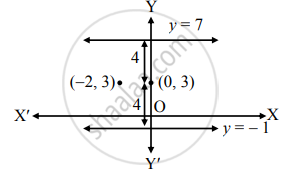Advertisements
Advertisements
प्रश्न
Write the equation of the line :
parallel to the X-axis and at a distance of 4 unit form the point (−2, 3)
उत्तर
Equation of a line parallel to the X-axis is of the form y = k (k > 0 or k < 0).
Since the line is at a distance of 4 units from the point (− 2, 3),
k = 4 + 3 = 7 or k = 3 – 4 = – 1
∴ The equation of the required line is y = 7 or y = – 1.

APPEARS IN
संबंधित प्रश्न
Write the equation of the line :
parallel to the Y−axis and at a distance of 5 unit form it and to the left of it
Obtain the equation of the line :
parallel to the Y−axis and making an intercept of 4 unit on the X−axis
Find the equation of the line passing through the points A(2, 0), and B(3, 4)
Find the equation of the line passing through the origin and parallel to AB, where A is (2, 4) and B is (1, 7)
Find the equation of the line having slope `1/2` and containing the point (3, −2).
Find the equation of the line containing point A(4, 3) and having inclination 120°
Find the x and y intercept of the following line:
`(3x)/2 + (2y)/3` = 1
Find the x and y intercept of the following line:
2x − 3y + 12 = 0
Find equations of lines which contains the point A(1, 3) and the sum of whose intercepts on the coordinate axes is zero.
Find equations of altitudes of the triangle whose vertices are A(2, 5), B(6, –1) and C(–4, –3).
Find the equations of perpendicular bisectors of sides of the triangle whose vertices are P(−1, 8), Q(4, −2), and R(−5, −3)
Find the coordinates of the orthocenter of the triangle whose vertices are A(2, −2), B(1, 1), and C(−1, 0).
Answer the following question:
Does point A(2, 3) lie on the line 3x + 2y – 6 = 0? Give reason.
Answer the following question:
Obtain the equation of the line containing the point (2, 4) and perpendicular to the Y−axis
Answer the following question:
Find the equation of the line having slope 5 and containing point A(–1, 2).
Answer the following question:
Find the equation of the line which contains the point A(3, 5) and makes equal intercepts on the co-ordinates axes.
Answer the following question:
The vertices of a triangle are A(1, 4), B(2, 3) and C(1, 6). Find equations of the medians.
Answer the following question:
The vertices of a triangle are A(1, 4), B(2, 3) and C(1, 6) Find equations of Perpendicular bisectors of sides
Answer the following question:
The vertices of a triangle are A(1, 4), B(2, 3) and C(1, 6) Find equations of altitudes of ∆ABC
Answer the following question:
The vertices of ∆PQR are P(2, 1), Q(−2, 3) and R(4, 5). Find the equation of the median through R.
Answer the following question:
Find the co-ordinates of the foot of the perpendicular drawn from the point P(−1, 3) the line 3x − 4y − 16 = 0
Answer the following question:
The perpendicular from the origin to a line meets it at (−2, 9). Find the equation of the line.
Answer the following question:
P(a, b) is the mid point of a line segment between axes. Show that the equation of the line is `x/"a" + y/"b"` = 2
If the equation kxy + 5x + 3y + 2 = 0 represents a pair of lines, then k = ____________.
If for a plane, the intercepts on the co-ordinate axes are 8, 4, 4, then the length of the perpendicular from the origin to the plane is ______
The lines `(x + 1)/(-10) = (y + 3)/-1 = (z - 4)/1` and `(x + 10)/(-1) = (y + 1)/-3 = (z - 1)/4` intersect at the point ______
The point A(b, a) lies on the straight line 2x + 3y = 13 and the point B(a, b) lies on the straight line -x + 4y = 5, then the equation of line AB is ______
The intercept of a line between the coordinate axes is divided by the point (1, 3) in the ratio 3 : 1. The equation of the line will be ______
A Plane cuts the coordinate axes X, Y, Z at A, B, C respectively such that the centroid of the Δ ABC is (6, 6, 3). Then the equation of that plane is ______.
Suppose the line `(x - 2)/α = ("y" - 2)/(-5) = ("z" + 2)/2` lies on the plane x + 3y – 2z + β = 0. Then (α + β) is equal to ______.
Let the perpendiculars from any point on the line 7x + 56y = 0 upon 3x + 4y = 0 and 5x – 12y = 0 be p and p', then ______.
Area of the parallelogram formed by the lines y = mx, y = mx + 1, y = nx and y = nx + 1 is equal to ______.
